Shengcai Liao
DirectSwap: Mask-Free Cross-Identity Training and Benchmarking for Expression-Consistent Video Head Swapping
Dec 10, 2025Abstract:Video head swapping aims to replace the entire head of a video subject, including facial identity, head shape, and hairstyle, with that of a reference image, while preserving the target body, background, and motion dynamics. Due to the lack of ground-truth paired swapping data, prior methods typically train on cross-frame pairs of the same person within a video and rely on mask-based inpainting to mitigate identity leakage. Beyond potential boundary artifacts, this paradigm struggles to recover essential cues occluded by the mask, such as facial pose, expressions, and motion dynamics. To address these issues, we prompt a video editing model to synthesize new heads for existing videos as fake swapping inputs, while maintaining frame-synchronized facial poses and expressions. This yields HeadSwapBench, the first cross-identity paired dataset for video head swapping, which supports both training (\TrainNum{} videos) and benchmarking (\TestNum{} videos) with genuine outputs. Leveraging this paired supervision, we propose DirectSwap, a mask-free, direct video head-swapping framework that extends an image U-Net into a video diffusion model with a motion module and conditioning inputs. Furthermore, we introduce the Motion- and Expression-Aware Reconstruction (MEAR) loss, which reweights the diffusion loss per pixel using frame-difference magnitudes and facial-landmark proximity, thereby enhancing cross-frame coherence in motion and expressions. Extensive experiments demonstrate that DirectSwap achieves state-of-the-art visual quality, identity fidelity, and motion and expression consistency across diverse in-the-wild video scenes. We will release the source code and the HeadSwapBench dataset to facilitate future research.
StoryAgent: Customized Storytelling Video Generation via Multi-Agent Collaboration
Nov 07, 2024
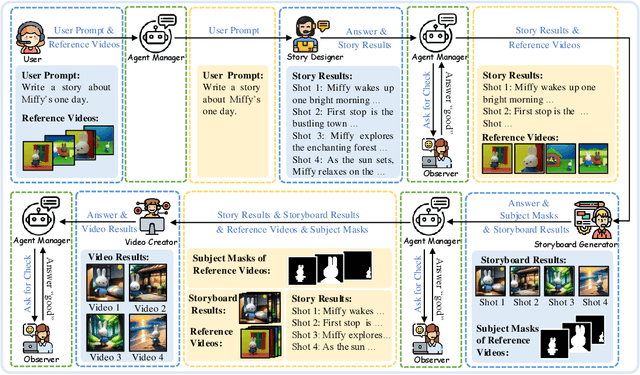


Abstract:The advent of AI-Generated Content (AIGC) has spurred research into automated video generation to streamline conventional processes. However, automating storytelling video production, particularly for customized narratives, remains challenging due to the complexity of maintaining subject consistency across shots. While existing approaches like Mora and AesopAgent integrate multiple agents for Story-to-Video (S2V) generation, they fall short in preserving protagonist consistency and supporting Customized Storytelling Video Generation (CSVG). To address these limitations, we propose StoryAgent, a multi-agent framework designed for CSVG. StoryAgent decomposes CSVG into distinct subtasks assigned to specialized agents, mirroring the professional production process. Notably, our framework includes agents for story design, storyboard generation, video creation, agent coordination, and result evaluation. Leveraging the strengths of different models, StoryAgent enhances control over the generation process, significantly improving character consistency. Specifically, we introduce a customized Image-to-Video (I2V) method, LoRA-BE, to enhance intra-shot temporal consistency, while a novel storyboard generation pipeline is proposed to maintain subject consistency across shots. Extensive experiments demonstrate the effectiveness of our approach in synthesizing highly consistent storytelling videos, outperforming state-of-the-art methods. Our contributions include the introduction of StoryAgent, a versatile framework for video generation tasks, and novel techniques for preserving protagonist consistency.
Realistic and Efficient Face Swapping: A Unified Approach with Diffusion Models
Sep 11, 2024Abstract:Despite promising progress in face swapping task, realistic swapped images remain elusive, often marred by artifacts, particularly in scenarios involving high pose variation, color differences, and occlusion. To address these issues, we propose a novel approach that better harnesses diffusion models for face-swapping by making following core contributions. (a) We propose to re-frame the face-swapping task as a self-supervised, train-time inpainting problem, enhancing the identity transfer while blending with the target image. (b) We introduce a multi-step Denoising Diffusion Implicit Model (DDIM) sampling during training, reinforcing identity and perceptual similarities. (c) Third, we introduce CLIP feature disentanglement to extract pose, expression, and lighting information from the target image, improving fidelity. (d) Further, we introduce a mask shuffling technique during inpainting training, which allows us to create a so-called universal model for swapping, with an additional feature of head swapping. Ours can swap hair and even accessories, beyond traditional face swapping. Unlike prior works reliant on multiple off-the-shelf models, ours is a relatively unified approach and so it is resilient to errors in other off-the-shelf models. Extensive experiments on FFHQ and CelebA datasets validate the efficacy and robustness of our approach, showcasing high-fidelity, realistic face-swapping with minimal inference time. Our code is available at https://github.com/Sanoojan/REFace.
HumanRefiner: Benchmarking Abnormal Human Generation and Refining with Coarse-to-fine Pose-Reversible Guidance
Jul 09, 2024



Abstract:Text-to-image diffusion models have significantly advanced in conditional image generation. However, these models usually struggle with accurately rendering images featuring humans, resulting in distorted limbs and other anomalies. This issue primarily stems from the insufficient recognition and evaluation of limb qualities in diffusion models. To address this issue, we introduce AbHuman, the first large-scale synthesized human benchmark focusing on anatomical anomalies. This benchmark consists of 56K synthesized human images, each annotated with detailed, bounding-box level labels identifying 147K human anomalies in 18 different categories. Based on this, the recognition of human anomalies can be established, which in turn enhances image generation through traditional techniques such as negative prompting and guidance. To further boost the improvement, we propose HumanRefiner, a novel plug-and-play approach for the coarse-to-fine refinement of human anomalies in text-to-image generation. Specifically, HumanRefiner utilizes a self-diagnostic procedure to detect and correct issues related to both coarse-grained abnormal human poses and fine-grained anomaly levels, facilitating pose-reversible diffusion generation. Experimental results on the AbHuman benchmark demonstrate that HumanRefiner significantly reduces generative discrepancies, achieving a 2.9x improvement in limb quality compared to the state-of-the-art open-source generator SDXL and a 1.4x improvement over DALL-E 3 in human evaluations. Our data and code are available at https://github.com/Enderfga/HumanRefiner.
ConsistentID: Portrait Generation with Multimodal Fine-Grained Identity Preserving
Apr 25, 2024



Abstract:Diffusion-based technologies have made significant strides, particularly in personalized and customized facialgeneration. However, existing methods face challenges in achieving high-fidelity and detailed identity (ID)consistency, primarily due to insufficient fine-grained control over facial areas and the lack of a comprehensive strategy for ID preservation by fully considering intricate facial details and the overall face. To address these limitations, we introduce ConsistentID, an innovative method crafted for diverseidentity-preserving portrait generation under fine-grained multimodal facial prompts, utilizing only a single reference image. ConsistentID comprises two key components: a multimodal facial prompt generator that combines facial features, corresponding facial descriptions and the overall facial context to enhance precision in facial details, and an ID-preservation network optimized through the facial attention localization strategy, aimed at preserving ID consistency in facial regions. Together, these components significantly enhance the accuracy of ID preservation by introducing fine-grained multimodal ID information from facial regions. To facilitate training of ConsistentID, we present a fine-grained portrait dataset, FGID, with over 500,000 facial images, offering greater diversity and comprehensiveness than existing public facial datasets. % such as LAION-Face, CelebA, FFHQ, and SFHQ. Experimental results substantiate that our ConsistentID achieves exceptional precision and diversity in personalized facial generation, surpassing existing methods in the MyStyle dataset. Furthermore, while ConsistentID introduces more multimodal ID information, it maintains a fast inference speed during generation.
Any-Shift Prompting for Generalization over Distributions
Feb 15, 2024Abstract:Image-language models with prompt learning have shown remarkable advances in numerous downstream vision tasks. Nevertheless, conventional prompt learning methods overfit their training distribution and lose the generalization ability on test distributions. To improve generalization across various distribution shifts, we propose any-shift prompting: a general probabilistic inference framework that considers the relationship between training and test distributions during prompt learning. We explicitly connect training and test distributions in the latent space by constructing training and test prompts in a hierarchical architecture. Within this framework, the test prompt exploits the distribution relationships to guide the generalization of the CLIP image-language model from training to any test distribution. To effectively encode the distribution information and their relationships, we further introduce a transformer inference network with a pseudo-shift training mechanism. The network generates the tailored test prompt with both training and test information in a feedforward pass, avoiding extra training costs at test time. Extensive experiments on twenty-three datasets demonstrate the effectiveness of any-shift prompting on the generalization over various distribution shifts.
ProtoDiff: Learning to Learn Prototypical Networks by Task-Guided Diffusion
Jun 26, 2023



Abstract:Prototype-based meta-learning has emerged as a powerful technique for addressing few-shot learning challenges. However, estimating a deterministic prototype using a simple average function from a limited number of examples remains a fragile process. To overcome this limitation, we introduce ProtoDiff, a novel framework that leverages a task-guided diffusion model during the meta-training phase to gradually generate prototypes, thereby providing efficient class representations. Specifically, a set of prototypes is optimized to achieve per-task prototype overfitting, enabling accurately obtaining the overfitted prototypes for individual tasks. Furthermore, we introduce a task-guided diffusion process within the prototype space, enabling the meta-learning of a generative process that transitions from a vanilla prototype to an overfitted prototype. ProtoDiff gradually generates task-specific prototypes from random noise during the meta-test stage, conditioned on the limited samples available for the new task. Furthermore, to expedite training and enhance ProtoDiff's performance, we propose the utilization of residual prototype learning, which leverages the sparsity of the residual prototype. We conduct thorough ablation studies to demonstrate its ability to accurately capture the underlying prototype distribution and enhance generalization. The new state-of-the-art performance on within-domain, cross-domain, and few-task few-shot classification further substantiates the benefit of ProtoDiff.
POCE: Pose-Controllable Expression Editing
Apr 18, 2023
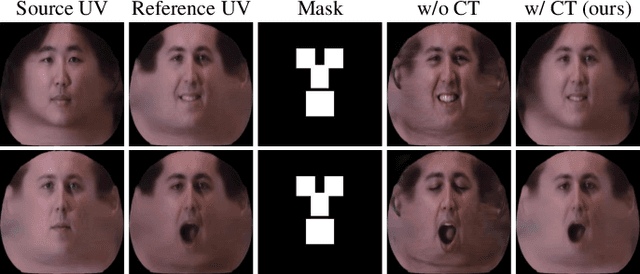


Abstract:Facial expression editing has attracted increasing attention with the advance of deep neural networks in recent years. However, most existing methods suffer from compromised editing fidelity and limited usability as they either ignore pose variations (unrealistic editing) or require paired training data (not easy to collect) for pose controls. This paper presents POCE, an innovative pose-controllable expression editing network that can generate realistic facial expressions and head poses simultaneously with just unpaired training images. POCE achieves the more accessible and realistic pose-controllable expression editing by mapping face images into UV space, where facial expressions and head poses can be disentangled and edited separately. POCE has two novel designs. The first is self-supervised UV completion that allows to complete UV maps sampled under different head poses, which often suffer from self-occlusions and missing facial texture. The second is weakly-supervised UV editing that allows to generate new facial expressions with minimal modification of facial identity, where the synthesized expression could be controlled by either an expression label or directly transplanted from a reference UV map via feature transfer. Extensive experiments show that POCE can learn from unpaired face images effectively, and the learned model can generate realistic and high-fidelity facial expressions under various new poses.
KD-DLGAN: Data Limited Image Generation via Knowledge Distillation
Mar 30, 2023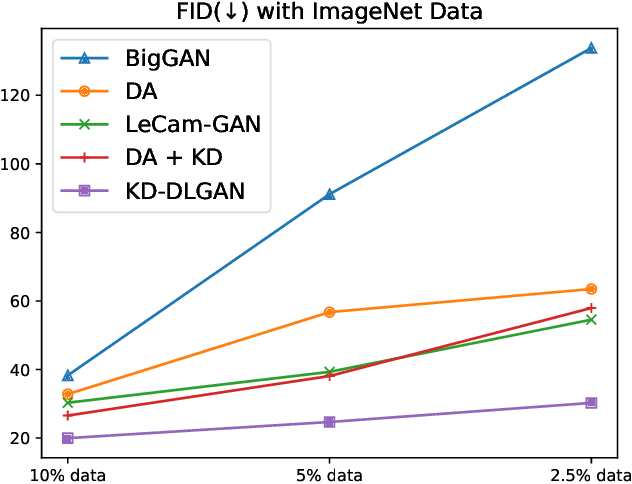
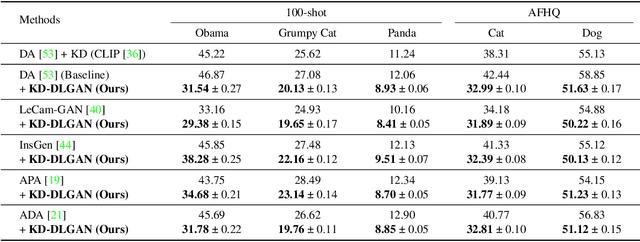
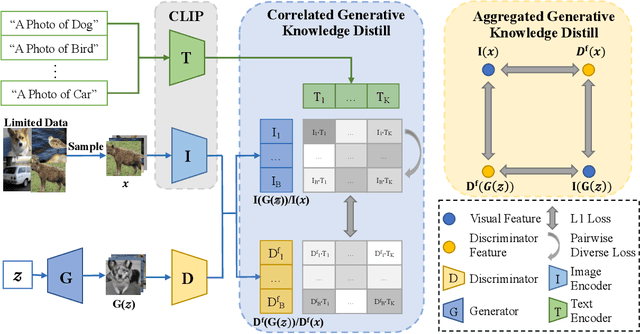
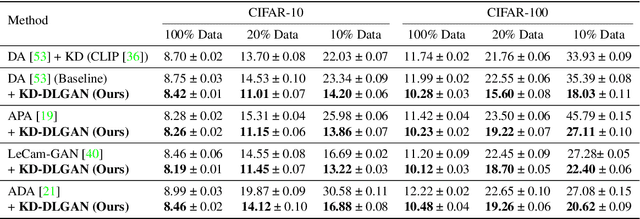
Abstract:Generative Adversarial Networks (GANs) rely heavily on large-scale training data for training high-quality image generation models. With limited training data, the GAN discriminator often suffers from severe overfitting which directly leads to degraded generation especially in generation diversity. Inspired by the recent advances in knowledge distillation (KD), we propose KD-DLGAN, a knowledge-distillation based generation framework that introduces pre-trained vision-language models for training effective data-limited generation models. KD-DLGAN consists of two innovative designs. The first is aggregated generative KD that mitigates the discriminator overfitting by challenging the discriminator with harder learning tasks and distilling more generalizable knowledge from the pre-trained models. The second is correlated generative KD that improves the generation diversity by distilling and preserving the diverse image-text correlation within the pre-trained models. Extensive experiments over multiple benchmarks show that KD-DLGAN achieves superior image generation with limited training data. In addition, KD-DLGAN complements the state-of-the-art with consistent and substantial performance gains.
Self-Paced Learning for Open-Set Domain Adaptation
Mar 21, 2023
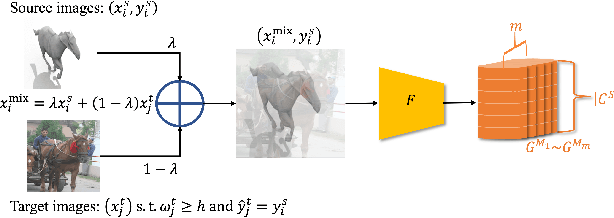
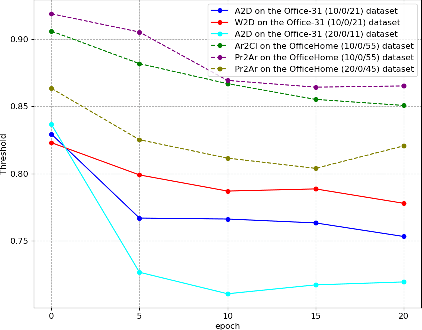
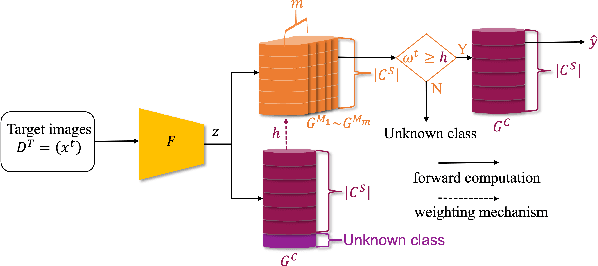
Abstract:Domain adaptation tackles the challenge of generalizing knowledge acquired from a source domain to a target domain with different data distributions. Traditional domain adaptation methods presume that the classes in the source and target domains are identical, which is not always the case in real-world scenarios. Open-set domain adaptation (OSDA) addresses this limitation by allowing previously unseen classes in the target domain. Open-set domain adaptation aims to not only recognize target samples belonging to common classes shared by source and target domains but also perceive unknown class samples. We propose a novel framework based on self-paced learning to distinguish common and unknown class samples precisely, referred to as SPLOS (self-paced learning for open-set). To utilize unlabeled target samples for self-paced learning, we generate pseudo labels and design a cross-domain mixup method tailored for OSDA scenarios. This strategy minimizes the noise from pseudo labels and ensures our model progressively learns common class features of the target domain, beginning with simpler examples and advancing to more complex ones. Furthermore, unlike existing OSDA methods that require manual hyperparameter $threshold$ tuning to separate common and unknown classes, our approach self-tunes a suitable threshold, eliminating the need for empirical tuning during testing. Comprehensive experiments illustrate that our method consistently achieves superior performance on different benchmarks compared with various state-of-the-art methods.
 Add to Chrome
Add to Chrome Add to Firefox
Add to Firefox Add to Edge
Add to Edge